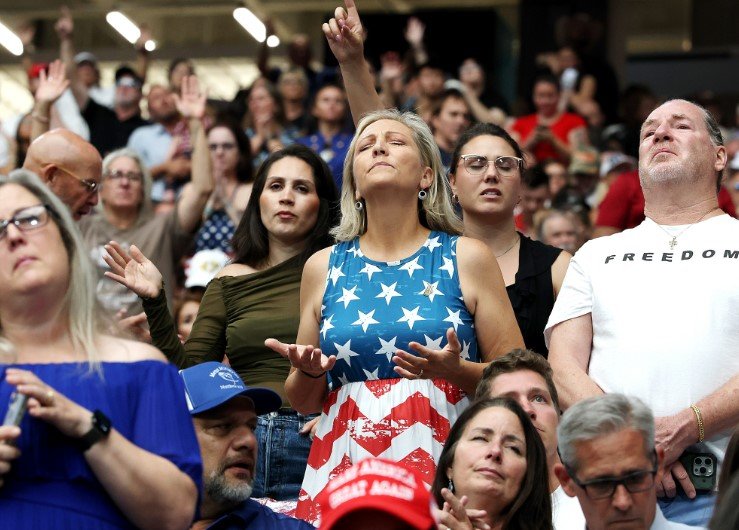Tens of thousands of Israelis came together in Tel Aviv’s Yarkon Park on October 7, 2025, to mark two years since the deadly Hamas attack that killed over 1,200 people and sparked a prolonged war. The event, filled with grief and calls for unity, honored victims and pressed for the release of 48 hostages still held in Gaza amid ongoing ceasefire talks.
Event Draws Massive Crowd Amid National Mourning
Around 30,000 people filled Yarkon Park for the nation’s largest memorial ceremony, organized by the Kumu movement founded by survivors and bereaved families. This gathering replaced an official state event, as the government chose to observe the Hebrew calendar anniversary later on October 16.
The atmosphere mixed solemn reflection with raw emotion. Attendees wore yellow ribbons and held posters of loved ones, creating a sea of remembrance. A burned car from the Gaza border and 48 empty yellow chairs symbolized the attack’s horror and the unresolved hostage crisis.
Speeches highlighted personal stories of loss and resilience. Yonatan Shamriz, whose brother was killed after escaping captivity, spoke of rebuilding a better Israel from the ashes of negligence.

Survivors and Families Share Heartbreaking Stories
Pre-recorded testimonies played on large screens, bringing tears to many. Fathers who lost children recited lyrics from a poignant song, evoking the pain of unfulfilled protection.
One widow shared her husband’s final radio calls during the kibbutz defense, underscoring the bravery amid chaos. Another recounted the mental health toll, including a police officer’s suicide after heroic actions on October 7.
These accounts painted a picture of enduring trauma. Two years on, the war has claimed thousands more lives, with Israel’s military operations in Gaza drawing global scrutiny.
The event also addressed the broader impact, including rising antisemitism worldwide. Recent surveys show increased incidents in places like the US and UK, linking back to the conflict’s ripple effects.
Performances and Symbols Evoke Hope and Defiance
Musical acts added emotional depth. Singer Eden Golan performed “I’m Coming Home,” urging international support for hostages. Pop star Eden Hason sang a ballad questioning suffering, with victims’ names displayed behind him.
Symbols like red anemones, Israel’s national flower, represented remembrance and renewal. A bullet-riddled shelter stood as a stark reminder of the attack’s brutality.
The ceremony featured a moment of silence for all fallen, from October 7 victims to soldiers in the ongoing war. Organizers emphasized mental health support, highlighting cases of post-traumatic stress among survivors.
Here are key elements from the memorial’s stage setup:
- Burned car from Gaza border communities
- Bullet-riddled bomb shelter
- 48 yellow chairs for remaining hostages
- Red anemones as symbols of hope
Calls for Hostage Release Amid Ceasefire Talks
Speakers repeatedly demanded action on the 48 hostages, including 47 taken on October 7 and one soldier’s body from 2014. Released hostage Omer Shem Tov expressed gratitude to rescuers and prayed for the captives’ return.
This plea came as indirect talks began in Egypt, mediated by the US, Egypt, and Qatar. Officials reported cautious optimism, with US President Donald Trump pushing a plan that includes hostage release and Hamas disarmament.
Prime Minister Benjamin Netanyahu has promised to achieve all war goals, but critics at the event accused the government of delays. Polls show most Israelis now favor ending the war, adding pressure for a deal.
The memorial connected to global reactions, with world leaders marking the anniversary while anti-Israel protests occurred in cities like London and Melbourne.
Government Criticism and Push for Accountability
Some remarks targeted leadership failures. Shamriz called for a state commission of inquiry into the October 7 lapses, a demand supported by public opinion but opposed by the government.
Bereaved mother Galit Dan spoke of healing over revenge, urging a return to core values. This reflected a broader sentiment of defiance, with attendees chanting for unity and action.
The event contrasted with last year’s divided commemorations, showing a grassroots push for non-politicized remembrance. As Israel faces multiple fronts, including threats from Hezbollah and Houthis, the memorial underscored internal fractures.
| Aspect | Details |
|---|---|
| Attendance | About 30,000 people |
| Organizers | Kumu movement (survivors and families) |
| Key Symbols | Burned car, yellow chairs, red anemones |
| Hostage Count | 48 still held in Gaza |
| Related Talks | Ceasefire negotiations in Egypt |
| Global Context | Rising antisemitism, international protests |
Looking Forward: Rebuilding and Reflection
Two years after the attack, communities like Kibbutz Kfar Aza are slowly rebuilding, with residents gathering at sites of fierce fighting. Initiatives like cleaning memorials and reframing victim photos show grassroots efforts to heal.
The war has reshaped Israeli society, with economic strains and mental health challenges. Recent events, such as a Yom Kippur attack in Manchester, highlight ongoing global tensions tied to the conflict.
As ceasefire hopes flicker, the memorial served as a call to action. It reminded attendees of the human cost and the need for resolution.
Share your thoughts on this memorial and the ongoing hostage situation in the comments below. If this story moved you, please pass it along to others who might find it meaningful.
